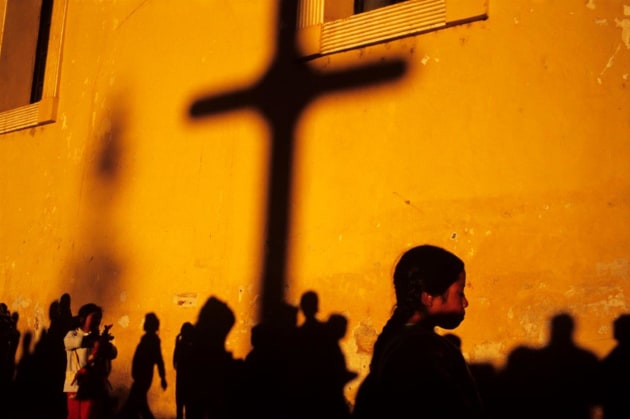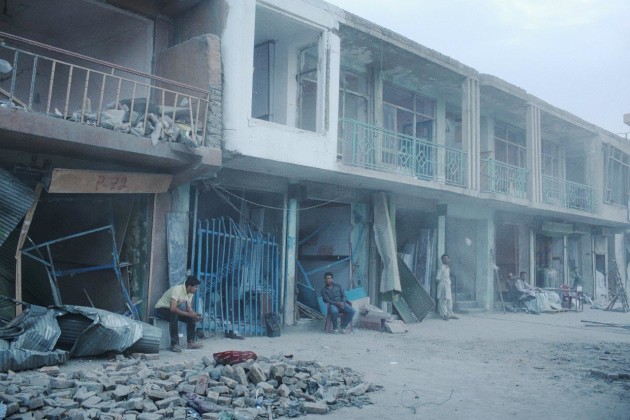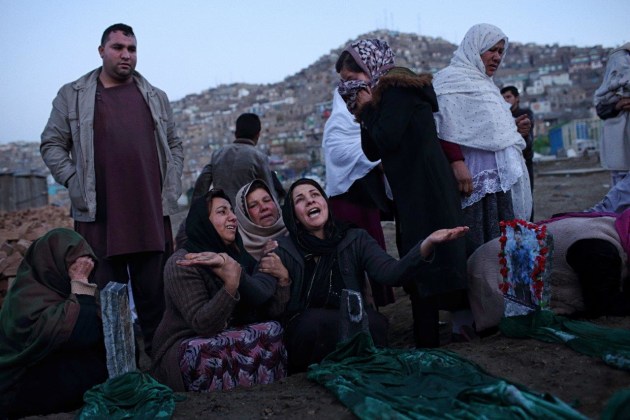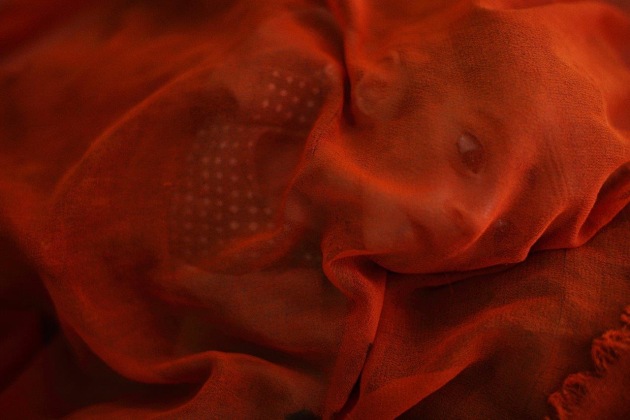Profile - Andrew Quilty (documentary photographer and photojournalist)
It was an instinctive attraction to communities living on the edge that took documentary photographer and photojournalist Andrew Quilty on a journey that ended with him basing himself in Afghanistan. Now with several years in the country and a Gold Walkley award under his belt, Quilty remains dedicated to telling the story of Afghanistan, one frame at a time. Christopher Quyen reports.
In the span of a fifteen-year career, to date, Australian-born documentary photographer and photojournalist, Andrew Quilty has built an extensive body of compelling work, and amassed an impressive list of awards and accolades. Now based in Kabul, Afghanistan, Quilty has dedicated his life to telling the story of Afghanistan as intimately as possible. His efforts have since seen him awarded him with the 2014 Nikon-Walkley Photographer of the Year, the 2015 Walkley Australian Freelance Journalist of the Year, and most recently, the 2016 Gold Walkley Award for Excellence in Journalism. In 2016, he also won both the Nikon-Walkley Photo of the Year and the News Photography category.

© Andrew Quilty.
So, what drew Quilty to Afghanistan in the first place? After a few failed Skype calls, a bomb going off during the interview, and having to resort to 3G Internet after his Wi-Fi failed, we learn that his reason goes well beyond portfolio-building or award-seeking, as others have done before him. At first, it’s about being drawn to older and less modern environments. Then, it’s about responsibility. It’s about making a real contribution to the world by telling the untold stories of Afghanistan.
Highway 1: A journey into photography
Before Quilty ventured into photography, in 2001 he embarked on a road trip around Australia on Highway 1, a network of highways that circumnavigate Australia, with his uncle’s camera and his two best friends. “I was given an old Nikon F3 by him. He was a professional photographer, as was his late brother, and they were both uncles that I looked up to,” Quilty recalls. “They were young at heart, and adventurous, and just cool dudes. I guess they were role models to an extent,” he says. Being given the camera by his uncle, Quilty says that it carried more weight than if someone else had given it to him. For six months, Quilty documented the road trip in what he describes as “a very amateurish way”, but he says that photography became a somewhat integral part of that trip. “It also made me realise that there was a career in this for me, or something that I should pursue,” he says.

Being able to take his camera into vastly different communities and environments on the road lent itself to Quilty’s aesthetic later in his career. “I’ve always been drawn to an older, less modern aesthetic and environments; places that are somewhat stuck in time, or that evoke an earlier time,” he says. “It’s probably something that has carried through, and Afghanistan falls into that category.” Quilty describes these places as communities living on the edge, and ever since his road trip, it has become something that he has developed an attraction towards. “Whether it’s on the edge of society or, like here in Afghanistan, on the edge of conflict and war, or on the edge of life and death, I enjoy poking my camera around in these sorts of places in a purely aesthetic sense,” Quilty says. “Maybe it’s something to do with growing up in Sydney in a middle-class environment. Now, I’m more interested in what’s outside that realm.”
An education: TAFE & Fairfax
Following the road trip, Quilty enrolled in a course studying photography at Ultimo TAFE, in Sydney. Despite it being “a very technical course targeting future commercial photographers since there was a lot of studio lighting content, and technical lighting theory and practice in the course,” Quilty was able to take a lot of what he learnt into the field as a photojournalist. One of the most valuable lessons he took away from TAFE that took only a minute to learn, was how to take a light reading off the palm of one’s hand. “It’s something that I use numerous times a day, every day,” he says. “Maybe going to TAFE to study photography wasn’t something that I had to spend three years doing, but it has always been something worth having in my understanding of light and the way light works.”
After graduating at the top of his class, his education continued at Fairfax where he started to meet a lot of photographers working for the Sydney Morning Herald. “They were all at the top of their game and their field,” says Quilty, “not only in Australia, but also internationally with some of them having World Press Photo awards.” Fairfax became a place of mentorship for Quilty and he was constantly inspired by his colleagues. “They were all doing work that I aspired to, and I didn’t know that I aspired to that sort of work until I met them,” Quilty says. “It was by virtue of their influence that I went down the path of documentary photography or photojournalism.”

The Cronulla Riots
It was just one day in his career, but it was a day that garnered considerable interest in the public realm internationally and brought Quilty into prominence in the industry. During the 2005 Cronulla riots, Quilty happened to find himself amid the commotion and took it upon himself to personally document the events. “I managed to succeed in documenting it in a way that was evocative of my style. It was also a successful documentation of a day of history in Australia,” says Quilty. After shooting the riot, his first idea was to send the work to a surfing magazine. “I was a surfer back then and I thought that being in Cronulla and being that whole beach culture, that they might be interested.”
It was only after showing the negatives to his colleagues at Fairfax that Quilty realised the potential of the work. “They told me, ‘You’re crazy, dude, don’t send it to a surfer magazine. You’ve got to do something more with this.’ So, I ended up contacting Time magazine and they ended up publishing it!” It was this international exposure that Quilty considers to be his first big break, however, when asked whether he considered this his biggest break, he says it was not. It was moving to Afghanistan.
Kabul, Afghanistan
Living and working in Afghanistan was never meant to become a full-time gig. Before he found himself in Kabul, Quilty was living and working in New York in 2013, “without a great degree of success,” he adds. And then the opportunity to move to Afghanistan came along. “A friend of mine who was a journalist asked if I knew any photographers she could work with, and I kind of stuck up my hand without thinking too much about it.” At that point, Quilty was feeling particularly unfulfilled in New York. “My plan was to go to Afghanistan for a couple of weeks, poke around, and then go back to New York. But two weeks turned into a month into two months into three months. By the end of it, that’s when I decided to base myself in Afghanistan.” The decision came with little to lose. He had no responsibilities holding him back. “I was single, didn’t have any kids, didn’t have a mortgage, I could afford not to make a heap of money, and I still can. In the end, I prioritised what was important to me, and I have no regrets doing so.”

© Andrew Quilty.
Since basing himself in Afghanistan in late 2013, Quilty now focuses his lens on stories that viewers don’t know about, or might be surprised to learn about. “The narrative that most people in the West are familiar with is that Afghanistan is a war-torn country. So, anything that provides a more nuanced perspective on Afghanistan is beneficial in whatever minute way,” says Quilty. His images show Kabul as a huge and functioning city. There are traffic jams, and cafes, and restaurants, and bowling alleys.
Something as simple as a picture of Quilty’s local barber can be enough to surprise and refute people’s perceptions of Afghanistan. “Telling the greater story of Afghanistan is part of the reason why I’m compelled to stay. It’s a developing story, and I’m one of the few photographers who’ve stayed here to illustrate the story. I enjoy being one of the few here,” Quilty says. “Professionally, though, it’s a place where I’m able to work and sustain myself, which is a practical matter I can’t ignore. But every day, I’m always ready to go out on my motorcycle and take pictures of whatever I come across, even if I’m not getting paid. I am just genuinely interested and curious, and anxious to keep on making pictures about this place.”
However, despite being able to witness and document Afghanistan so intimately over the past few years, Quilty admits that there are still some challenges preventing him from doing the work that he wishes to create. “In reality, there is half the country that I can’t document, which is the Taliban side of the conflict. It is half the story that is pretty much off-limits to me and is a big shortfall in what I’m trying to accomplish here,” he says.

A long time ago, the Taliban was a centralised organisation and had a media wing to oversee what photojournalists were reporting on. However, since the insurgency, it has become increasingly difficult for media to access the Taliban. “It would be very foolish or irresponsible to do it,” says Quilty. “It’s very hard to know who you’re talking with, and who you can trust, and whether these people will see you through or imprison you, hold you for ransom, or put you on a YouTube video with your head getting chopped off.” Quilty sees the situation as both unfortunate and frustrating as he believes the Taliban could benefit from media coverage. “I think there are some stories from behind the Taliban lines that might paint a picture contrary to the popular narrative of good versus evil,” Quilty says. “I’ve heard of schools operating in Taliban areas and that there is greater stability and trust in the Taliban, which contrasts with [other] reports of government military tearing down villages, with many civilian casualties in the process. I’m not being biased or pro-Taliban, but this is me being objective and reporting on the facts as they were.”
Get in, get what you need, get out
When Quilty is out in the field, his mind is always focused on the job. “It can be quite tense mostly because you’re trying to get what you need and get out,” he says. “It depends where you are, but often in Afghanistan, access is increasingly difficult. It’s not impossible, but it’s often suicidal.” Unfortunately, for someone who prefers to spend time with their subjects, this means that Quilty is often working under serious limitations, particularly with regards to time restrictions and exposure to gunfire. “When you’re working in conflict zones, you don’t want to be around for too long. Often that means you’re leaving without the best work, or being rude and leaving prematurely. Sometimes, I feel like I’m leaving behind part of the story that I wish I could have documented,” he admits.
This has become a qualm that Quilty has had to come to terms with. It also means that sometimes he must put his emotions aside in the worst situations. “I’m often in situations that are emotional, tense, sad, dangerous, or all these things at once. But in those moments, specifically, I must be 100% on my game and think of nothing, but working. Anything else, including reflection, can come later,” he says. While this could come across as insensitive, at the end of the day, Quilty is there to tell a story. “If I can’t get that, then there’s no point being there.”
As a result, Quilty has to always be on guard when he’s out in the field. Danger can often be present and to not be cautious would be a mistake on his part. “You always want to be looking over your shoulder,” he says. “One tip that a photographer gave me, when you’re not 100% sure of the people around you, is to keep one eye on the reflection behind you in the LCD screen of your camera so you’ve got an eye in the back of your head.” Quilty takes this practice with him both on the battlefield and on the street. “Being aware of your surroundings is very important, and even when I go out photographing on the streets of Kabul, I instinctively do these things and all my senses are on hyper-drive,” says Quilty. “When I get home after half an hour on the streets, I feel so exhausted!”
Just like Capa
Quilty doesn’t think about his photographic philosophy too much anymore. His time in the field has made it almost instinctive, but if he had to describe his philosophy he says it comes down to one famous quote by Robert Capa. “If you’re not close enough, you’re not good enough.” It has become essential to the way Quilty works in the field – with a wide-angle lens. “I’m very anti long lenses and, while there are exceptions, I feel like if you need a long lens to photograph an intimate scene, then that’s like cheating and you’re not adequately respecting your subjects,” says Quilty. “You need to bring yourself into that intimacy or know the same risk involved as your subjects. It’s all about respect for me.”
Quilty does however acknowledge that there are often times where you may be disrespectful with a wide-angle lens, but he says it’s about communication. “You need the respect and authorisation of the people in the pictures to be there,” he says. “If you’re able to do that and be a part of the scene, then I think that’s the best way to document. Whether or not you agree with what they’re doing in front of your camera, the fact that they’ve allowed you to be there with your camera is something you should never take for granted.”
With Capa as one of Quilty’s main inspirations to his working philosophy, he was also influenced by his mentors. “In a more personal and mentoring way, people from the collective, Oculi have been the most immediate influences to my work,” says Quilty. He references photographers such as Dean Sewell, Nick Moir, and James Brickwood as people he looked up to and whose work he admired. “I’ve always aspired to their abilities and they’ve really helped me along the way,” he says. “Now I look more towards photographers who have a similar style and ways of working, such as Paolo Pellegrin, Daniel Berehulak, and Larry Towell. In all honesty, though, Stephen Dupont’s work in Afghanistan really influenced me to come here.”

Quilty’s kit
Quilty’s kit reflects his ‘Capa-esque’ approach to photography. When out in the field, he typically tends to rely on two Nikon D810 bodies with fixed focal length lenses. “90% of the time I use 35mm lenses,” Quilty says. But sometimes, shooting with a DSLR isn’t always the best choice of camera. Consequently, Quilty’s next best options include his Fujifilm X-Pro2 and his iPhone 6. “With a DSLR, every click of the camera can sound like a gunshot,” he says. “I use my Fuji X-Pro2 when I need to be more surreptitious and subtle. I like using the small mirrorless camera in situations where I need to be quiet or where I need to be more respectful. Sometimes I’ll use my iPhone when I don’t have my camera on me, although there are some shots that I took on iPhone that I wished I took on my DSLR.”
Awards are more than just accolades
“When you’re in the act of taking pictures, awards and recognition are far from your mind,” Quilty says. For him, telling the story of Afghanistan has always been the key motivation. When Quilty stumbled upon the scene and captured the image that would win him the Gold Walkley award, he thought it was such a significant and momentous scene to be confronted by, but he never looked at it in terms of awards. “I was looking at The Man on the Operating Table as a significant event in the war, and the Western involvement and folly here. It was representative of a lot more than that one incident of the American warplane bombing the hospital in Kunduz. I guess I could see the symbolism beyond just a dead body,” says Quilty. It was only after coming back to Kabul, spending time putting together the story, meeting the family of the man on the operating table, publishing it, and then receiving e-mails to enter the image into awards that Quilty thought that this picture could attract attention.
When the image didn’t win an award at the World Press Photo, an editor at National Geographic wrote to him. “He wrote to me saying sorry that the image didn’t win, not because it would’ve given me attention, and recognition, and career advantages . . . awards give pictures another life, and he believed that the picture deserved another life.” That’s when it occurred to Quilty, that awards are so much more than just accolades; they’re a chance for the image to be immortalised in history. So, when it was announced that the picture won a Gold Walkley, not only did the image get the recognition it deserved, but it also acted as a symbol for Quilty to other photographers that a single image could make a real difference. “That was the first time a photographer won a Gold Walkley, so I was happy for photography’s sake that the picture won. For me, it was a call to arms for photographers to not only see themselves as picture makers or the people that fill websites with pretty pixels, but people with a responsibility, or possibility to go beyond that and make a real contribution to the world with their imagery.”
A story worth telling
When asked about whether he has thought of returning to Sydney to settle down, Quilty suggests that it’s maybe something he’ll consider in the future. “As much as I love being in Sydney and hanging out by the beach, I’m lucky enough to love the work I do and I’m always looking forward to going back to Kabul,” he says. For those who wish to chase a career in documentary photography and photojournalism, Quilty advises all photographers to shoot with purpose and passion. “You must do it for the right reasons – because you want to tell a story, not because you want to build your portfolio,” he says. “I know some foreign photographers who are only in Afghanistan for that reason. I don’t agree with that.” So, tell a personal story. Find a vacuum in coverage, and that could be the beginnings of your photojournalism career. But first and foremost, you need to be passionate. Quilty’s passion for his work in Afghanistan drives him every day. “You need to be passionate about whatever you point your camera at. Whether it’s conflict, people, or sport.”
Contact
Andrew Quilty

